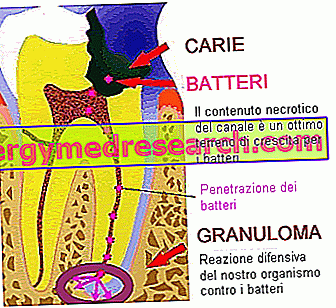Generality
Pears are the fruit, or rather the false fruit, of trees of the genus Pyrus, belonging to the Rosaceae family (subfamily Pomoidee), spontaneous in the humid - temperate areas of Europe and Asia.

The best known pears belong to the Pyrus communis species and reach maturity starting from the end of July; following the harvest, the pears can be preserved for a long time through the use of cold in a controlled atmosphere, increasing the percentages of nitrogen in the air and eliminating as much as possible the ethylene responsible for the progress of maturation; alternatively, they can undergo the typical industrial processes of preserved fruit.
The varieties of pears most marketed in our country and in Europe are: William pears, Max Red Bartlet pears, Decana pears, Abate Fétel pears, Kaiser pears, Conference pears, Spinella pears, Nashi pears, thigh pears, herculean pears, cocomerina pears, pears pears from Emilia-Romagna, Mantovana pears, noble pears and Crassana pears.
Nutritional characteristics
Pears are false fruits (like apple and medlar); from the botanical point of view, in fact, the real fruit is the core, while the edible portion is the fleshy receptacle covered by the fibrous skin.
Pear fiber: fresh pears fall into the category of foods that can be called "raw", unprocessed, or that can be eaten whole and possibly raw. Habitually, many use to peel pears but - ignoring for a moment the fear that the pesticide treatments of conventional agriculture may remain on or inside the fruit - from a strictly dietary point of view it is an absolutely undesirable habit; the peel of pears (and not only of these) contains high amounts of dietary fiber, a nutritional component with a very high satiating potential, as well as modulating the intestinal absorption of lipids and preventive of disorders (as well as neoplastic transformations) of the large intestine .
NB . The peel of the pears could constitute an undesirable element if taken by people with particular problems such as: diverticulosis, diarrhea, partial resection of the large intestine, etc.
Pear water: pears contain 84% of their weight in water; this, which would seem a foregone dietary component, is not at all. Also, like dietary fiber, it is a typical constituent of "raw" foods that must be introduced daily AT LEAST in quantities equal to 1ml per kcal.
Pear sugars: the available sugars (therefore digestible) of the pears consist mainly of monosaccharides and, to be precise, fructose; fructose is a carbohydrate which, since it cannot be used directly by human cells for energy production, needs a prior conversion to glucose by the liver. This metabolic process determines a low glycemic index and gives the pears the merit of being considered a consumable sugary food (in the right portions) even by people suffering from alterations of glucose tolerance (eg Diabetes type 2).
Pear vitamins: pears contain good amounts of vitamins; however, it is possible to benefit from this nutritional characteristic ONLY by preferring fresh ones since, being essentially thermolabile nutrients, cooking for storage in cans would reduce concentrations in the pulp to a minimum. Moreover, considering that it is a food to be consumed mainly raw, even though it has "proportionally" reduced the amount of vitamins compared to some vegetables to be cooked, pears contribute greatly to the achievement of recommended vitamin rations for thermolabile molecules (eg. the pears contain about 25-30% of vitamin C of the potatoes which, for their part, need to be cooked, inexorably losing almost all of the ascorbic acid).
Pear mineral salts: the mineral salts of pears are different and abundant; of all, potassium (K) stands out, a determining factor in sports nutrition and in the diet against hypertension.
Pears energy: the energy of pears is not excessive; they provide about 35kcal per 100g of edible portion and therefore are also very suitable for IPOcaloric feeding.
Portions of consumption
First of all, pears are fruits that should be consumed close to ripeness and not in the other periods of the year, avoiding all the derivatives preserved in cans or candied or dehydrated or in spirits, etc. On the other hand, it is true that, thanks to their ability to keep themselves in a modified atmosphere, pears (such as apples, some citrus fruits and kiwis) are able to completely cover our need for fruit for the winter period; it is not a trivial matter.
Pears belong to the category of fruit, therefore the relative portions fluctuate between 200 and 600g per day (around 1-3 fruits); obviously it is a very generic discourse that deserves to be contextualized in the specific caloric regime, recalling that - even though it is a low energy food - the excess in consumption would inexorably lead to an imbalance of the overall diet.
Recipes with pears
Tartlets with pears and chocolate
Pear and chocolate tarts
X Problems with video playback? Reload from YouTube Go to Video Page Go to Video Recipes Section Watch the video on youtubeRisotto with pears and cheese
Risotto with pears and cheese
X Problems with video playback? Reload from YouTube Go to Video Page Go to Video Recipes Section Watch the video on youtubePears and Chocolate with Almonds and Chili
Pears and Chocolate with Almonds and Chili
X Problems with video playback? Reload from YouTube Go to Video Page Go to Video Recipes Section Watch the video on youtube



